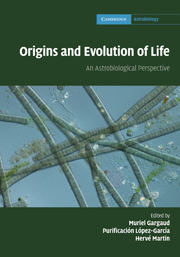Book contents
- Frontmatter
- Contents
- List of contributors
- Foreword
- Preface
- Part I What is life?
- Part II Astronomical and geophysical context of the emergence of life
- 6 Organic molecules in the interstellar medium
- 7 Cosmochemical evolution and the origin of life: insights from meteorites
- 8 Astronomical constraints on the emergence of life
- 9 Formation of habitable planets
- 10 The concept of the galactic habitable zone
- 11 The young Sun and its influence on planetary atmospheres
- 12 Climates of the Earth
- Part III The role of water in the emergence of life
- Part IV From non-living systems to life
- Part V Mechanisms for life evolution
- Part VI Life in extreme conditions
- Part VII Traces of life and biosignatures
- Part VIII Life elsewhere?
- Index
7 - Cosmochemical evolution and the origin of life: insights from meteorites
from Part II - Astronomical and geophysical context of the emergence of life
Published online by Cambridge University Press: 04 February 2011
- Frontmatter
- Contents
- List of contributors
- Foreword
- Preface
- Part I What is life?
- Part II Astronomical and geophysical context of the emergence of life
- 6 Organic molecules in the interstellar medium
- 7 Cosmochemical evolution and the origin of life: insights from meteorites
- 8 Astronomical constraints on the emergence of life
- 9 Formation of habitable planets
- 10 The concept of the galactic habitable zone
- 11 The young Sun and its influence on planetary atmospheres
- 12 Climates of the Earth
- Part III The role of water in the emergence of life
- Part IV From non-living systems to life
- Part V Mechanisms for life evolution
- Part VI Life in extreme conditions
- Part VII Traces of life and biosignatures
- Part VIII Life elsewhere?
- Index
Summary
Introduction
Meteorites have so far provided our best analytical window into the cosmochemical evolution of the elements that make up Earth's complex chemical systems. They are for the most part fragments of asteroids, i.e. of the small-sized and odd-shaped planetesimals that orbit the Sun in great numbers between Mars and Jupiter. According to the regular spacing of inner planets from the Sun (the Titius–Bode law), this orbit should be occupied by a planet, but it appears that the smaller lumps of early Solar-System material on their way to form a planet in this region fell under the strong gravity of the gas-giant Jupiter, which slung many away and left the rest unable to fully coalesce. Asteroids, therefore, are the remnants of a planet that never was and, just like comets and other smaller bodies in the Solar System that avoided the geological reprocessing of planet formation, may offer a pristine record of early Solar-System material. Yet, they have the important distinction of being concentrated in a crowded orbit and, subjected still to the gravitational pull of planets nearby and many collisions, regularly send their fragments to the Earth as meteorites, whose direct laboratory analyses secure unequivocal data of their extraterrestrial material.
In the case of carbonaceous meteorites, the delivery has taken on an astrobiological significance because this subgroup of meteorites contains abundant and diverse organic material, including compounds having identical counterparts in the biosphere, such as amino acids (e.g. Pizzarello et al., 2006).
- Type
- Chapter
- Information
- Origins and Evolution of LifeAn Astrobiological Perspective, pp. 98 - 117Publisher: Cambridge University PressPrint publication year: 2011
- 1
- Cited by



